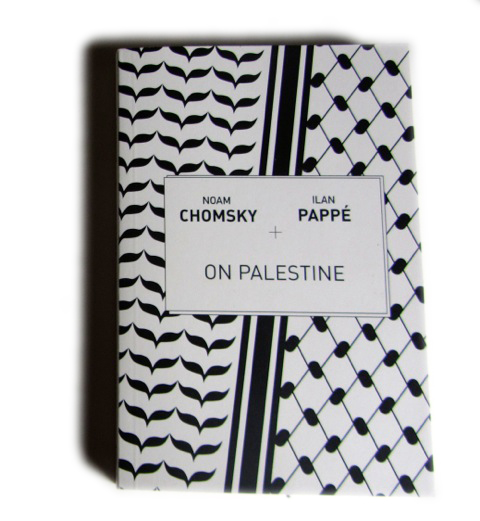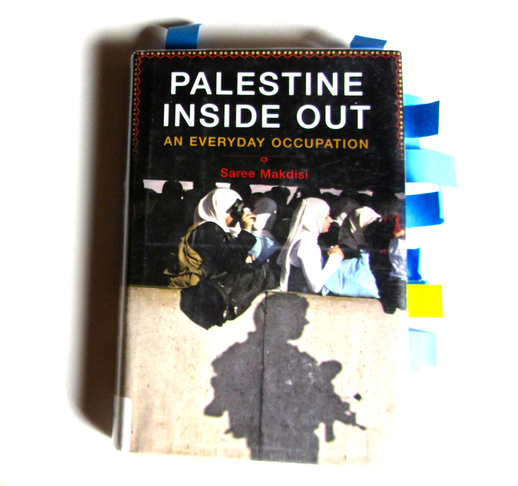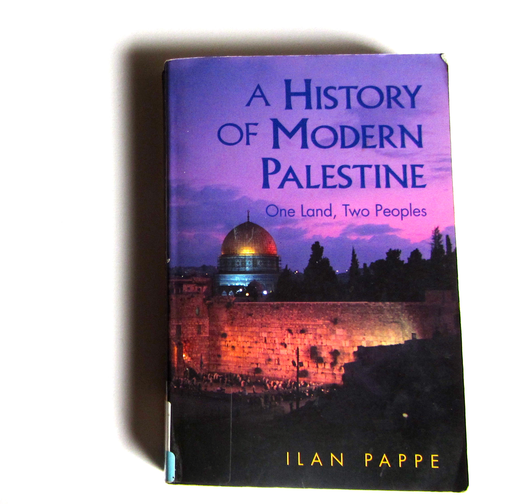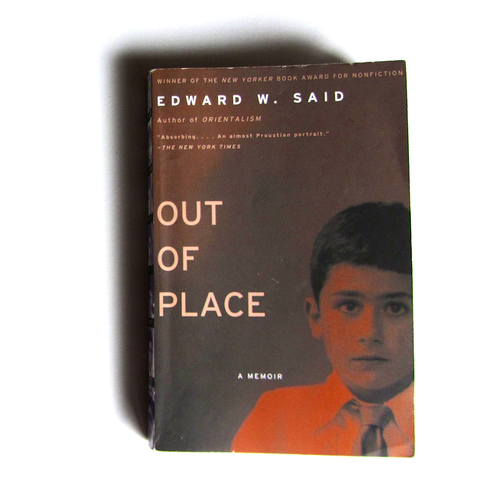Book immersion
In researching how artwork can be made that is poetic and political without being didactic, I took time to read intensively on the history of Palestine.[13] Originally seeking text for my moving images, my initial structure was to limit my text to the effects of the Occupation on non-human beings, namely plant life, in Palestine. (I abandoned this limitation, only to return to it later, before abandoning all factual text completely). Astonished by the history of Israel-Palestine, I felt obligated to include human centred facts to put audiences from different cultural contexts on the same page.
Facts on Palestine
The genesis of modern Israel began in the late nineteenth century. Intended as a land that would allow European Jews to escape discrimination, the country’s formation nevertheless followed models of European colonial expansionism. Edward Said (1992) notes that while the idea of displacing persons in Belgium or Switzerland for the Jewish homeland would have been a laughable idea, Argentina, Uganda, Australia, and Tasmania were considered as sites for the new country. Britain partitioned Palestinian land for Israel through the Balfour Declaration of 1917 in one of the last phases of its (official) empire.
The early idea of the State of Israel was not without opponents in the Jewish community. Edwin S. Montagu, the only Jewish minister in the British Parliament at the time of the Balfour Declaration, warned that the creation of such a country would increase anti-Semitism worldwide. Opposing the system wherein citizenship would be granted on the grounds of religion, he wrote in 1917, ‘[The proposal] seems to me to be admitted by those who take a bigoted and narrow view of one particular epoch of the history of Palestine, and claim for the Jews a position to which they are not entitled’ (Makdisi 2008: 238). Various groups of Orthodox Jews, then and now, also refute the idea of the Jewish Holy Land in Israel. Contesting Zionist readings of the Torah as historically inaccurate, they assert that Zionism betrays Judaism’s religious and moral principles through its use of violence on the Palestinian people.
The declassification of official Israeli documents in the 1980s prompted a movement known as ‘New Historiography’. Journalist Tom Segev’s 1949: The First Israelis (1986) chronicles the violence of Palestinian expulsion through data from its early settlers. It details early ruptures and hierarchies among the settlers, divided between European, Russian, and Arab Jews. Ilan Pappé’s A History of Modern Palestine (2004) and The Ethnic Cleansing of Palestine (2006) take a less sympathetic view of Israel’s formation, asserting that if the events of 1948 had taken place today, they would fall under the category of ‘ethnic cleansing’ in international law.
[13] The books of greatest use to this research were Edward Said’s The Question of Palestine (first published 1979, revised 1992) and Saree Makdisi’s Palestine Inside Out: An Everyday Occupation (2008), which work on different yet complimentary registers. Said’s book is a (sadly) timeless treatise on the discourse that surrounds Palestine following the failed Camp David agreements of 1979. It is the second in his trilogy on the Middle East that started with Orientalism (1978) and ended with Covering Islam: How the Media and the Experts Determine How We See the Rest of the World (first published 1981, revised 1997). Makdisi’s volume compliments Said’s with facts and figures on the occupation from 1948 to the present.
The non-human in Israel and Palestine
Since its origin in 1917, the Jewish National Fund (JNF) has looked to ‘set roots’ in its new homeland (Bardenstein 1999). Planting a mixture of deciduous and coniferous trees not native to the region, the JNF has attempted to reconstruct the European landscapes they left behind (Bardenstein 1999; Said 1992). Doing so upon the ruins of former Palestinian villages, the JNF altered the topography of the nation.
One of Israel’s great claims to environmental ingenuity has been its socialist-modelled communes known as kibbutzim. Israeli leaders from Golda Meir to military commander Moshe Dayan were born in them. Nevertheless, Kibbutzim have historically relied on inexpensive Arab labour to maintain and cultivate their land and operations (Bardenstein 1999; Said 1992).
The mass destruction of Palestinian olive groves occurred in direct relation to losses associated with human life. Numbers of Palestinian refugees presently total 4.7 million human beings; 45 per cent of the remaining population in Palestine relies on olive harvests for their income. From 2001 to 2005 alone, Israel destroyed 465,945 olive trees. Eighty per cent of Palestinian farmers have been denied access to their olive trees. In 2000, one million olive trees in the occupied territories were inaccessible to Palestinian farmers due only to the separation wall (Makdisi 2008: 65).
Discourse
Israeli discourse is a primary concern in writing on Palestine (Chomsky and Pappé 2015; Masalha 1992; Pappé 2004, 2006; Said 1992, 1997). Israel’s self-presentation to the West as a democratic, environmental/agricultural pioneer and long-standing victim in the Middle East has relied on such discourse. A chief agent of this discourse is also, of course, the arts.
Israeli rhetorical strategies also compliment Euro-American discourse about Islam and the Arab world. Where ‘terrorism’ is a generalised threat to Israel and democracy itself, ‘anti-terrorist’ measures also serve American and European oil interests in the Middle East. The figure of the veiled Muslim woman is used by Western feminists and the Western right alike to confirm rhetorically the backwardness of the Middle East and, in turn, Western superiority (Ahmed 1982). Since 9/11 (and before) these strategies have benefited European and American anti-immigration interests, preventing the Palestinian, Syrian, Afghani, and Iraqi refugees of American wars and European settler colonialism from accessing the benefits of any nation’s citizenship. In the face of these conflicts of interest, it has been specifically difficult for Palestinian resistance, activism, and peace-making to take hold. Despite recent tensions between Israel and their closest ally, the United States, the Israeli military government was funded twenty-five billion dollars by the Obama administration alone (Bruck 2015).
Thinking about the Holocaust in the twenty-first century
When considering Palestine, the tragic dimensions of the Jewish Holocaust are not to be ignored.[14] That it took place at all shakes fundamental concepts of the European enlightenment, evoking questions at the heart of posthumanism (Braidotti 2013). While the ethnic exceptionalism used to destroy European Jewry was not unlike that used against Palestinians and in the Middle East today, the spectre of anti-Jewish racism continues to present a formidable obstacle to the resolution of the conflict. People everywhere are rightly sympathetic to the historical plight of Jews: dislocation, concentration camps, genocide. (That Americans are far less sympathetic to the similar plight of Native or African Americans, or that Europeans are less sympathetic toward the peoples of their former colonies, remains overall the case in point.)
Effective scholarship on Israel and Palestine must thus take care to survey the effects of internalised racism both on victims and on perpetrators. As Said (1992) points out, it is difficult within Euro-American discourse to acknowledge that Israelis, once victims, have become the oppressors of Arab Israelis and Palestinians. Analysis of the Holocaust can thus not be performed in Eurocentric isolation. Twenty-first-century Holocaust studies must begin to ask why and through what structures non-European nations of the Middle East have been made to pay the price for German and European anti-Semitism.
[14] It should go without saying that any critical commentary on Palestine cannot set Holocaust denial or delegitimatisation as its task. It must also be noted that a key discourse used to dispel criticism of Israel and its violations of human rights is that of accusing Israel’s critics of ‘anti-Semitism’. In these instances, the Holocaust is often conjured, even when geographically inapplicable.
Military archives
The records of Israeli prime ministers were among the more surprising findings of my research.
Yitzhak Shamir, who served as Prime Minister of Israel from 1983 to 1984 and 1986 to 1992 was responsible for the murder of UN mediator Count Folke Bernadotte in 1949 (Makdisi 2008). At the time, Shamir served as leader of the Stern Gang, a group of Jewish ‘extremists’ (Pappé 2004: 135). A former advocate for Jewish rights in WWII Europe, the Swedish Bernadotte argued for Palestinian rights and repatriation as early as 1948 (Said 1992) yet met with little support from Israel. Bernadotte’s assassination ultimately cleared the way for the complete military take over of the Negev, in the southern part of Palestine. By 1967, the issue of Palestinian repatriation was no longer an issue for the UN and United States, until then the strongest proponents of repatriation.
Former Prime minister Ariel Sharon, deemed ‘a man of peace’ by George W. Bush, was responsible for the 1953 Qibya massacre. Killing 143 Palestinians in the course of a few hours, explosives were set up around forty-eight homes while the residents were still inside them. Nearly thirty years later, Sharon would oversee the massacres of Palestinian refugees in the Sabra and Shatilla camps of Beirut, Lebanon, in which over two thousand adults and children were killed in the course of three days. Sharon served as Prime Minister of Israel from 2001 to 2007 after a thirty-year career in the Israeli parliament.
In 1967, Israel engaged in what Ilan Pappé (2004: 188) called ‘a classic Blitzkrieg’ for territory, creating an additional two hundred thousand Palestinian refugees. The 1967 war was notable for its use of napalm bombs, which resulted in the deaths of ten thousand Egyptian soldiers (Shazly 2011). The 1967 war resulted in the annexation of Jerusalem as well as Egypt’s Sinai Peninsula and Syria’s Golan Heights.
As a means of gaining a deeper understanding, this period of my research was invaluable. These videos emerged from this period and reflect my attempt to merge the information I had discovered with the animal imagery of Palestinian Wildlife Series.
Shown above, A Civilized Man, video experiment with voiceover, Rania Khalil, 2015. Running time: 3 minutes 37 seconds.
In the video experiment A Civilized Man, left, I quote a passage from Edward Said’s The Question of Palestine, in which Said links the occupation of Palestinian agricultural land with the history of colonialism worldwide.
A civilized man, it was believed, could cultivate the land because it meant something to him; on it, accordingly, he bred useful arts and crafts, he created, he accomplished, he built. For an uncivilized people, land was either farmed badly (i.e., inefficiently by Western standards) or it was left to rot. From this string of ideas, by which whole native societies who lived on American, African, and Asian territories for centuries were suddenly denied their right to live on that land, came the great dispossessing movements of modern European colonialism, and with them all the schemes for redeeming the land, resettling the natives, civilizing them, taming their savage customs, turning them into useful beings under European rule. Land in Asia, Africa, and the Americas was there for European exploitation, because Europe understood the value of land in a way impossible for the natives. (1992: 75–76)
The Parties are Zionism, video experiment with voiceover.
Rania Khalil, 2015. Running time: 1 minute 21 seconds.
1967, didactic experiments at their height. (Never shown to public.)
Video by Rania Khalil, 2015. Running time: 2 minutes 16 seconds.
next page: Afrofuturism












